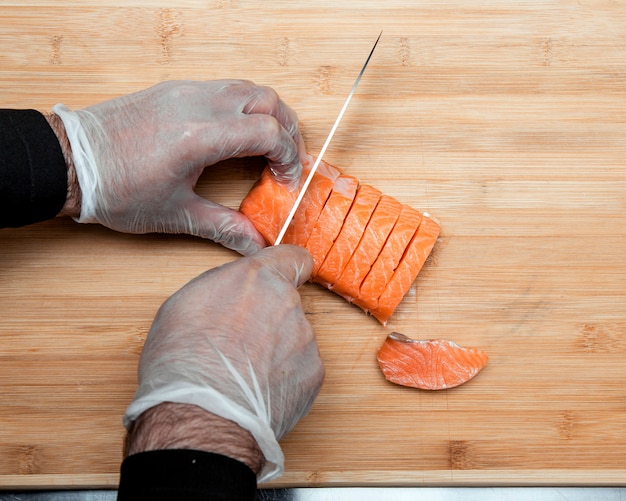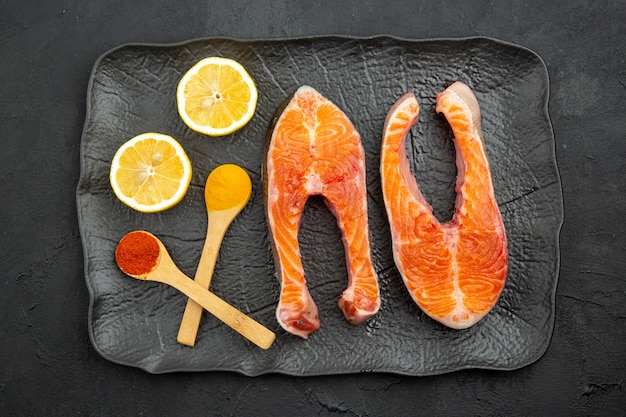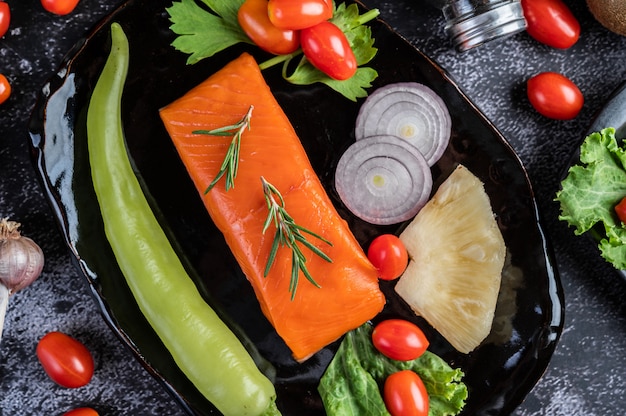(Part 1) Understanding Sockeye Salmon

A Fish with a Story
Sockeye salmon, sometimes called red salmon, is a real standout in the world of fish. It's renowned for its rich, deep flavour and its gorgeous pink flesh. But there's more to it than just taste. It’s a nutritional powerhouse, brimming with omega-3 fatty acids, protein, and vitamin D, making it a healthy choice for your dinner table.
What makes sockeye salmon so special is its incredible lifecycle. These fish migrate up rivers to spawn, and during this journey, their flesh takes on that incredible deep red colour. This natural process is what gives the fish its distinctive flavour and nutritional value. It’s a story in every bite!
The Art of Choosing the Perfect Sockeye Salmon
Picking the right sockeye salmon is crucial. You want to ensure you’re getting the freshest, most flavorful piece possible. Here’s what to look for when you’re at the fishmonger:
- Freshness is paramount: Look for salmon with bright, shiny skin and clear, bright eyes. The flesh should be firm and springy to the touch, indicating freshness.
- Colour matters: The flesh should be a vibrant pink or red, with a nice even colour throughout. Avoid any that are pale or dull, as these might be older and have a less intense flavour.
- Trust your nose: Fresh sockeye salmon should have a mild, slightly sweet smell. If it smells fishy or ammonia-like, it's a sign of spoilage, and it's best to avoid it.
And don’t be shy! If you're unsure, ask the fishmonger! They're your best source of information. They know their stuff and they’re happy to help you choose the perfect piece of salmon. They’re the experts, after all.
Keeping Your Sockeye Salmon Fresh
Storing sockeye salmon properly is essential to keep it fresh and delicious. If you're buying whole salmon, keep it chilled in the fridge for up to 2 days. Wrap it tightly in plastic wrap or place it in an airtight container to prevent freezer burn. If you're buying fillets, they can last for up to 3 days in the fridge, following the same wrapping or container rules.
For longer storage, you can freeze sockeye salmon. Wrap it tightly in plastic wrap or foil, then put it in a freezer-safe bag or container. Frozen sockeye salmon can last for up to 3 months. Remember that frozen salmon will have a slightly different texture than fresh, so it’s best to use it in dishes where that doesn’t matter too much, like stews or soups.
(Part 2) The Classics: Roasting and Grilling

roasted sockeye salmon: A Simple Delights
Roasted sockeye salmon is a real crowd-pleaser. It’s incredibly easy to prepare, and the result is juicy, tender salmon with a beautiful caramelized crust. Here’s how I do it:
- Preheat your oven to 400°F (200°C). Get a baking sheet and line it with some parchment paper. It makes clean-up a breeze, and saves you from scrubbing burnt-on food later.
- Season the salmon with salt, pepper, and whatever herbs you fancy. I love a good sprinkle of rosemary and thyme. But really, use whatever suits your taste! Experiment with different herbs and spices to find your perfect combination.
- Place the salmon on the baking sheet, skin-side down, and roast for 12-15 minutes, or until the fish is cooked through and flakes easily with a fork. You'll know it's done when the internal temperature reaches 145°F (63°C).
Tip: For a bit of extra flavour, add some lemon wedges or slices to the baking sheet alongside the salmon. The lemon will infuse the salmon with a bright, citrusy taste. It's a simple trick, but it really makes a difference.
Grilling Sockeye Salmon: A Summertime Feast
Grilling sockeye salmon is a perfect way to enjoy this fish during the warmer months. It gives the fish a nice smoky flavour and a slightly charred crust. Here’s how I do it:
- Clean your grill grate and heat it to medium-high. I prefer to use gas grills, but charcoal works too, just make sure the coals are white-hot.
- Season the salmon with salt, pepper, and any herbs you like. I love a good mix of garlic powder and paprika. It gives the salmon a nice kick.
- Place the salmon on the grill, skin-side down, and cook for 3-4 minutes. Once the skin is nicely browned, flip the salmon and cook for another 3-4 minutes, or until it's cooked through. Remember, you want the fish to be flaky but still moist.
Tip: For an extra touch of flavour, drizzle the salmon with some lemon juice or olive oil before grilling. It adds a bit of tang and moisture, and it helps to prevent the fish from sticking to the grill.
(Part 3) Pan-frying: Quick and Delicious

pan-fried salmon with a Crispy Crust
Pan-frying sockeye salmon is a great way to make a quick and delicious dinner. It’s perfect for weeknights when you’re short on time. Here's how I do it:
- Heat some olive oil in a large skillet over medium-high heat. You want the oil to be hot enough to sizzle when you add the salmon. If the oil isn’t hot enough, the salmon will stick and won’t cook evenly.
- Season the salmon with salt, pepper, and any herbs or spices you like. For a crispy crust, try coating the salmon with a mix of breadcrumbs, grated Parmesan cheese, and chopped herbs. This creates a beautiful golden crust that adds texture and flavour.
- Carefully place the salmon in the hot skillet, skin-side down. Cook for 3-4 minutes, or until the skin is nicely browned and crispy.
- Flip the salmon and cook for another 2-3 minutes, or until it's cooked through. The flesh should be flaky and opaque.
Tip: To prevent the salmon from sticking to the pan, make sure the oil is hot enough before you add the fish. And if you're using a nonstick pan, you can skip the extra oil.
Pan-fried salmon with lemon and Herbs
For a light and refreshing meal, try pan-frying sockeye salmon with lemon and herbs. Here’s how I do it:
- Heat some olive oil in a large skillet over medium-high heat.
- Season the salmon with salt, pepper, and a squeeze of lemon juice. The acidity of the lemon will brighten the flavour of the salmon.
- Place the salmon in the hot skillet, skin-side down. Cook for 3-4 minutes, or until the skin is nicely browned and crispy.
- Flip the salmon and cook for another 2-3 minutes, or until it's cooked through. Just before serving, sprinkle with fresh herbs like dill, parsley, or chives. It adds a beautiful aroma and flavour.
Tip: For an extra touch of flavour, add a knob of butter to the skillet after you've removed the salmon. Let the butter melt and baste the salmon with the pan sauce. It's a simple step, but it adds a richness and depth to the dish.
(Part 4) Beyond the Basics: Getting Creative
Sockeye Salmon with a Honey-Glaze
If you’re looking for a sweet and savoury flavour combination, try this honey-glazed sockeye salmon. It's a real winner!
- Preheat your oven to 400°F (200°C). You want the oven nice and hot to create a beautiful caramelized glaze.
- In a small bowl, whisk together honey, soy sauce, and a touch of ginger. The proportions can be adjusted to your taste. I prefer a stronger honey flavour, so I use a bit more honey than soy sauce. Experiment with the ratio to find what suits you best.
- Place the salmon on a baking sheet lined with parchment paper, and brush it with the honey-glaze. You can add some extra herbs like thyme or rosemary if you like.
- Bake for 12-15 minutes, or until the fish is cooked through and the glaze is bubbly and caramelized. The glaze should have a beautiful, glossy finish.
Tip: Serve this salmon over a bed of steamed rice or quinoa for a complete and satisfying meal. And if you're feeling adventurous, you can add some chopped roasted vegetables like broccoli, carrots, or asparagus to the baking sheet alongside the salmon. It's a great way to add some extra colour and flavour to your dish.
Sockeye Salmon with a Spicy Mango Salsa
This recipe is a real taste explosion! The sweetness of the mango complements the rich flavour of the salmon perfectly, while the spice from the jalapeno adds a nice kick.
- Start by making the salsa. Combine chopped mango, red onion, cilantro, jalapeno, lime juice, and a pinch of salt in a bowl. Adjust the amount of jalapeno to your spice tolerance. I like it hot, so I add a good amount of jalapeno. But you can start with less and add more if you need to.
- While the salsa is marinating, preheat your oven to 400°F (200°C). The oven will create a beautifully cooked salmon.
- Season the salmon with salt, pepper, and a little paprika. Place it on a baking sheet lined with parchment paper.
- Roast the salmon for 12-15 minutes, or until it's cooked through. You want it flaky and moist, not dry.
- Serve the salmon topped with the mango salsa and a dollop of sour cream or Greek yogurt. The creamy texture contrasts nicely with the sweet, spicy salsa.
Tip: If you don't have fresh mango, you can use frozen mango chunks. Just make sure to thaw them completely before chopping them.
(Part 5) side dishes: Perfect Pairings
Complementary Flavors for Your Sockeye Salmon
Now, let's talk about side dishes. Finding the right accompaniments for your sockeye salmon is half the fun! You've got endless options, but here are some of my personal favourites:
- Steamed vegetables: A simple side of steamed broccoli, asparagus, or green beans goes beautifully with sockeye salmon. They provide a refreshing contrast to the richness of the fish.
- Roasted vegetables: For a bit more flavour, try roasting vegetables like carrots, Brussels sprouts, or potatoes. They get a lovely caramelized crust and a deep flavour that complements the salmon.
- Rice or quinoa: A bed of rice or quinoa is a classic pairing for salmon. It’s a simple and satisfying base for your meal.
- Salad: A fresh salad with mixed greens, cherry tomatoes, cucumbers, and a light vinaigrette makes a refreshing addition to any salmon dish.
The beauty of sockeye salmon is that it’s so versatile, you can really pair it with almost anything you like. Just experiment and find what works for you!
(Part 6) FAQs
1. Is Sockeye Salmon Good for You?
Absolutely! Sockeye salmon is a powerhouse of nutrients. It's packed with omega-3 fatty acids, protein, vitamin D, and selenium. These nutrients are great for your heart health, brain function, and overall well-being. Eating sockeye salmon regularly can contribute to a healthier lifestyle.
2. How Can I Tell if Sockeye Salmon is Fresh?
Fresh sockeye salmon will have bright, shiny skin, clear, bright eyes, and firm, springy flesh. It should also have a mild, slightly sweet smell. If it smells fishy or ammonia-like, it's not fresh and you should avoid it.
3. How Long Can I Keep Sockeye Salmon in the Fridge?
Whole sockeye salmon can be kept in the fridge for up to 2 days, while fillets can last for up to 3 days. Just make sure you wrap them tightly in plastic wrap or place them in an airtight container to preserve freshness.
4. Can I Freeze Sockeye Salmon?
Yes, you can freeze sockeye salmon. Just wrap it tightly in plastic wrap or foil, then place it in a freezer-safe bag or container. Frozen sockeye salmon can last for up to 3 months. Remember that frozen salmon will have a slightly different texture than fresh, so it’s best to use it in dishes where that doesn’t matter too much, like stews or soups.
5. What Are Some Good Side Dishes for Sockeye Salmon?
Some great side dishes for sockeye salmon include steamed vegetables, roasted vegetables, rice or quinoa, and a fresh salad. The beauty of sockeye salmon is that it’s so versatile, you can really pair it with almost anything you like.
(Part 7) Sockeye Salmon: A culinary adventure
So there you have it, my guide to cooking sockeye salmon. I hope you’ve been inspired to try some of these recipes. From simple roasting to more adventurous dishes, there's something for everyone. Remember, the most important thing is to have fun and experiment in the kitchen!
And please, share your experiences with me! Tell me what you make, how it turns out, and what your favourite sockeye salmon recipe is. I'm always eager to hear from fellow foodies and to learn from your culinary adventures. Happy cooking!
(Part 8) A Little Bit of Personal Experience
My Sockeye Salmon Memory
You know, I’ve got a special memory tied to sockeye salmon. It was a summer evening, and we were having a BBQ with friends. I had just caught this beautiful sockeye salmon on a fishing trip earlier that week, and I was so excited to share it with everyone. The salmon was grilled to perfection, with a smoky flavour and a crispy skin. It was served with a simple salad and a chilled glass of white wine. It was the perfect summer meal, enjoyed under the warm glow of the setting sun. It’s moments like those that remind me how special sockeye salmon truly is. It’s not just a fish; it's a taste of adventure, a symbol of summer, and a memory that will stay with me forever.
Everyone is watching

Prime Rib Roast Cooking Time Chart: Per Pound Guide
Cooking TipsPrime rib roast. Just the name conjures images of lavish dinners, crackling fires, and hearty laughter. It’s ...

How Long to Bake Potatoes in the Oven (Perfect Every Time)
Cooking TipsBaked potatoes are a staple in my kitchen. They're incredibly versatile, delicious, and surprisingly easy to m...

Perfect Rice Every Time: The Ultimate Guide to Cooking Rice
Cooking TipsAs a self-proclaimed foodie, I've always been a bit obsessed with rice. It's the foundation of countless cuisi...

The Ultimate Guide to Cooking Asparagus: Tips, Techniques, and Recipes
Cooking TipsAsparagus. The mere mention of this spring delicacy conjures up images of vibrant green spears, crisp and burs...

Ultimate Guide to Cooking the Perfect Thanksgiving Turkey
Cooking TipsThanksgiving. Just the word conjures up images of overflowing tables laden with delicious food, the scent of r...
